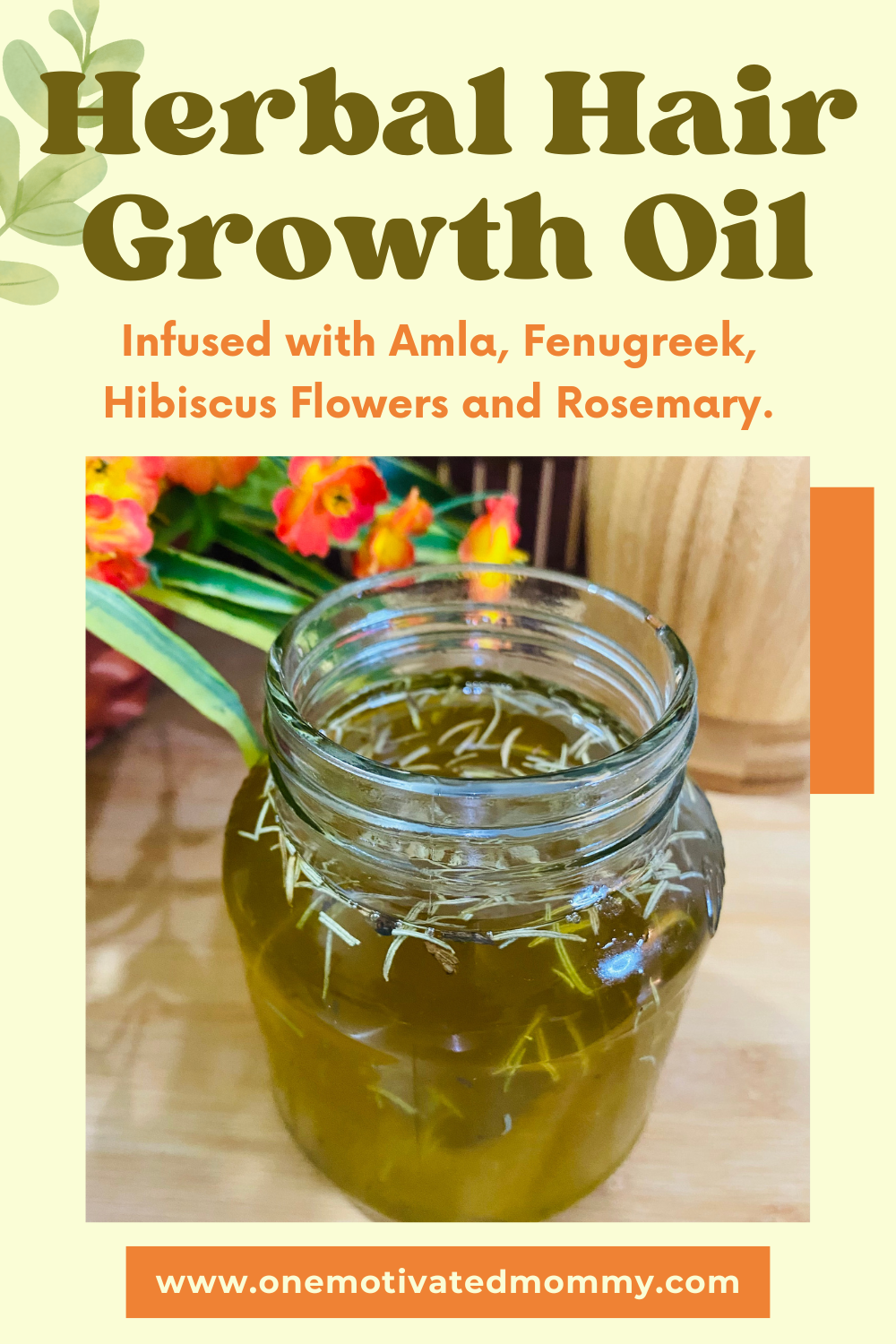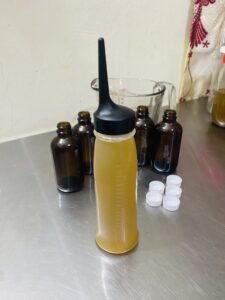I have been passionate about hair care since I embarked on my hair journey in 2010 and restored my damaged hair to the healthiest and longest it has ever been. You can read more about my hair journey here.
Growing up and living in the Caribbean, I am fortunate to be surrounded by a rich blend of cultures and natural ingredients that work wonders in our beauty rituals. From herbs and spices introduced by the East Indians, such as methi (fenugreek), curry leaves, turmeric and amla to castor oil and shea butter from Africa, we have an abundance of remedies sourced from the bounty of the earth.
Incorporating some of these ingredients into your hair care routine can help to maximise your hair growth potential by harnessing the goodness of nature. One effective way to do this is by using an herbal hair oil infused with these beneficial ingredients.
The Power of Herbal Hair Oil
This DIY herbal hair oil is packed with potent Ayurvedic ingredients and nourishing oils. It combines the moisturizing and protective properties of coconut, grapeseed and castor oils and is infused with amla, fenugreek, rosemary and hibiscus leaves.
Research has shown that plant extracts such as rosemary can effectively stimulate hair growth, making this herbal oil infusion a powerful addition to your hair care routine.
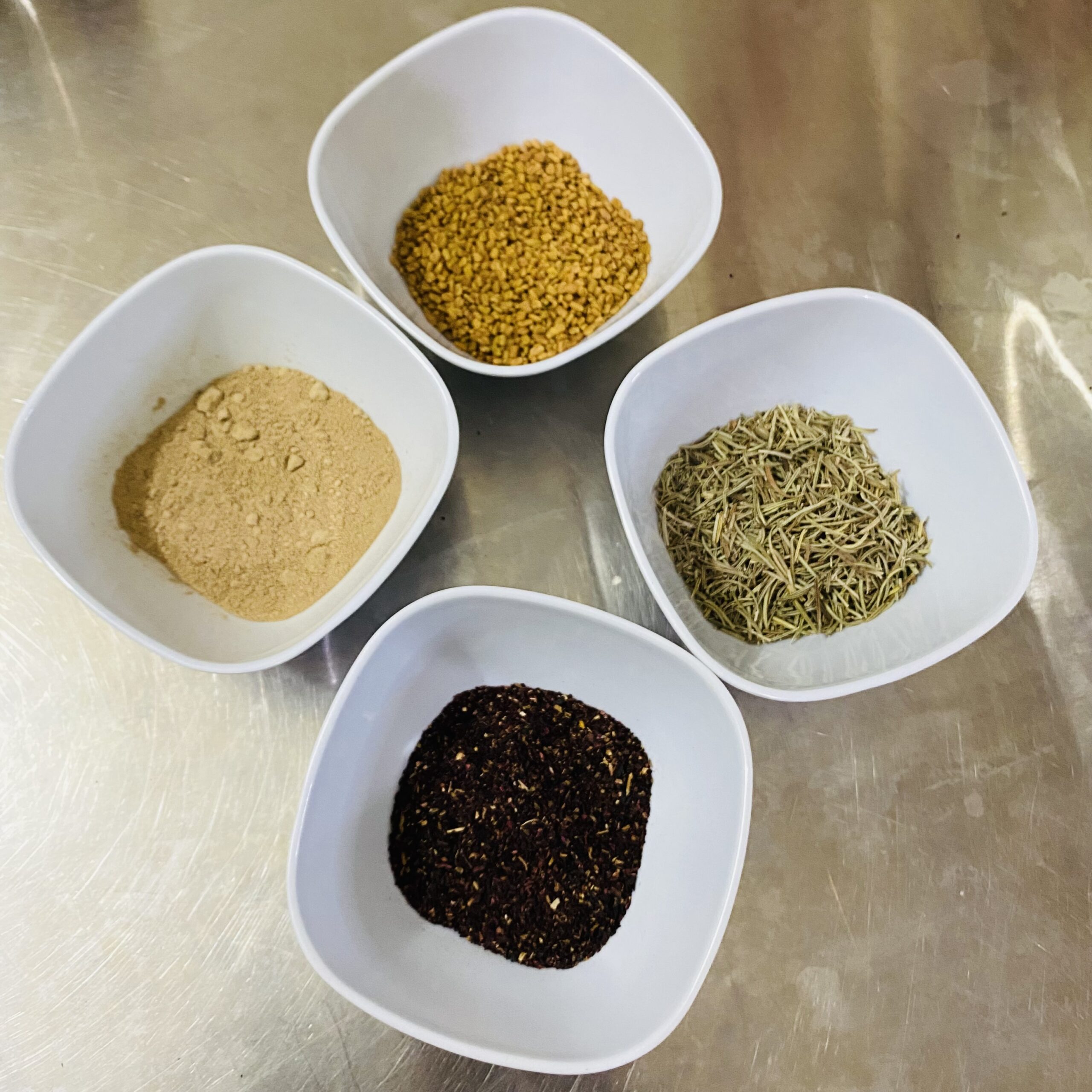
Methods of Infusing Oils with Herbs
In the Caribbean, it is common to see our grandmothers using the sun’s heat to naturally infuse oils with herbs to extract their essence. This age-old method can be applied to create your herbal hair oil in addition to some more contemporary processes. Here are three methods:
Sun Infusion Method:
- Place the herbs and oils in a glass jar.
- Place the jar in a sunny window for about three weeks, shaking the jar occasionally.
- Strain to separate the herbs from the oils.
- Store it in a clean jar in a cool, dark place.
Double-boiler Method
- Place the oil and herbs in a double boiler over low heat and let it simmer for 3 to 5 hours.
- Ensure the temperature doesn’t exceed 100°F to avoid destroying the beneficial properties of the herbs.
- Allow it to cool then strain to separate the oil from the herbs.
- Store it in a clean jar in a cool, dry place.
Slow Cooker Method
- Add the oils and herbs to the slow cooker.
- On the lowest temperature, usually the ‘Keep Warm’ setting, allow the mixture to infuse for 3 to 4 hours, stirring occasionally.
- Allow the infusion to cool then strain to remove the herbs from the oils.
- Store in a clean glass jar in a cool, dry place.
Note: When creating an oil infusion, it is best to use dried herbs to avoid the growth of mould or bacteria in your final product.
Herbal Hair Oil Ingredients and Their Benefits
Coconut Oil: Moisturising and anti-fungal properties.
Jamaican Black Castor Oil: Promotes hair growth and reduces hair loss.
Grapeseed Oil: Lightweight, rich in antioxidants and vitamins.
Amla (Indian Gooseberry): Strengthens hair follicles and promotes hair growth.
Hibiscus Flowers: Conditions the hair and prevents dryness.
Fenugreek (Methi) Seeds: Reduces hair thinning and dandruff.
Rosemary: Stimulates hair growth and improves circulation.
Peppermint Essential Oil: Stimulates hair growth and provides a refreshing feeling.
Lavender Essential Oil: Soothes the scalp and adds a calming fragrance.
Vitamin E: Antioxidant properties, prolongs shelf-life of oils.
Making Your Herbal Hair Oil
I used the slow cooker method as it is a quicker way to infuse the hair oil without compromising the beneficial properties of the herbs.
While creating this DIY herbal hair oil, I made a larger batch for my personal use, amounting to about 32 ounces, but you can easily adjust the recipe to suit your needs. Below I also include the full recipe scaled down to approximately 8 ounces. For these smaller quantities, I would use the double-boiler method or sun-infusion if it is too little for a slow cooker.
By starting with a smaller amount of oil, you can test its efficacy and see if it suits your hair care needs.
Scaled Down Recipe:
To make an 8-ounce batch, use the following proportions:
Oils:
– 4 oz Coconut oil
– 2 oz Grapeseed oil
– 2 oz Jamaican Black Castor oil
– 0.13 oz Vitamin E oil
Herbal Blend:
– 0.15 oz Amla powder
– 0.2 oz Fenugreek (Methi) seeds
– 0.07 oz Rosemary
– 0.07 oz Hibiscus Flowers
Essential Oils (Optional):
– 0.13 oz Peppermint oil
– 0.13 oz Lavender oil
Feel free to adjust the quantities based on your preferences and needs.
Ingredients – 32 Ounce Recipe
Oils:
- 16 oz Coconut Oil
- 8 oz Grapeseed Oil
- 8 oz Jamaican Black Castor Oil
- 0.5 oz Vitamin E Oil
Herbal Blend:
- 0.6 oz Amla powder
- 0.85 oz Fenugreek (Methi) seeds
- 0.3 oz Dried Rosemary
- 0.3 oz Hibiscus Flowers
Essential Oils (Optional):
- 0.5 oz Peppermint Essential oil
- 0.5 oz Lavender Essential oil
Directions to Make Herbal Hair Oil – Slow Cooker Method
Gather your tools and ingredients.
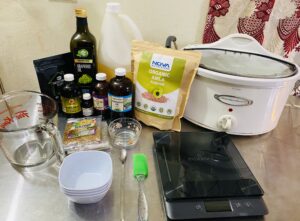
Measure the carrier oils (coconut and grapeseed oil) and add them to the slow cooker.
- Note: I infused only the coconut and grapeseed oils. I left the castor and vitamin E oil for the cool-down phase so as to better preserve their properties without heat.
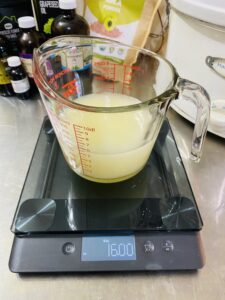
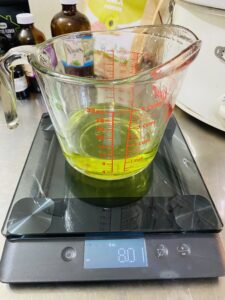
Next, weigh or measure the herbal ingredients.
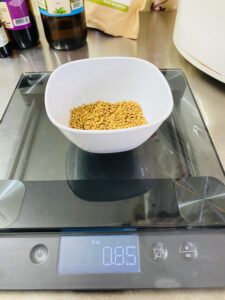
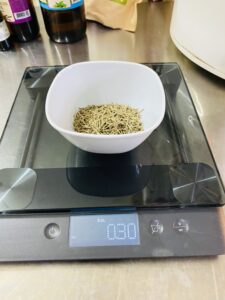
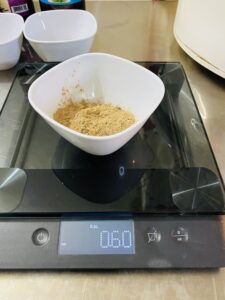
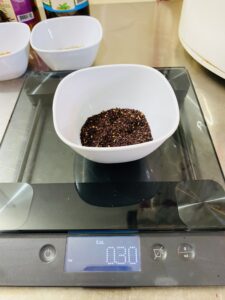
Add the herbal ingredients to the oils in the slow cooker.
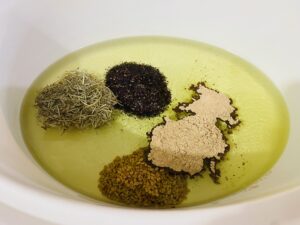
Cover the slow cooker and set it on the lowest setting for 3 to 4 hours. I set it to ‘Keep Warm’ on my slow cooker.
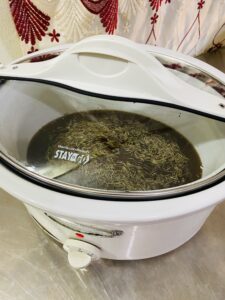 Occasionally stir the mixture.
Occasionally stir the mixture.
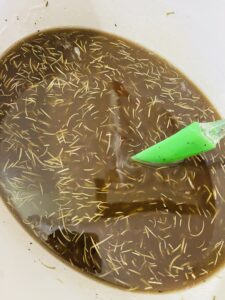
After the infusion period, let it cool to room temperature, then strain the oils using a mesh strainer or cheesecloth.
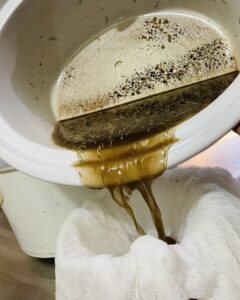
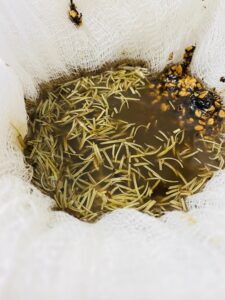
Next, add the Jamaican Black Castor Oil and Vitamin E Oil and stir to mix.
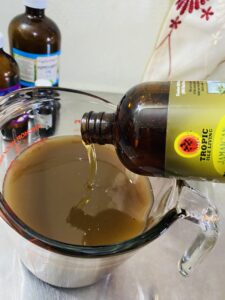
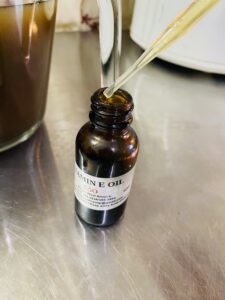
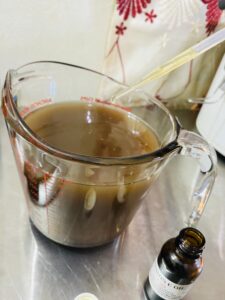
If you are adding essential oils, add them in and mix thoroughly to combine.
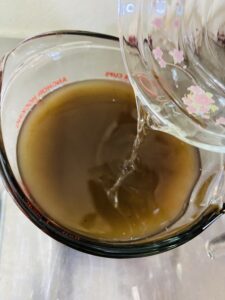
Cover the container and set it aside in a cool, dry place for 48 to 72 hours to allow the amla particles to settle, then decant or pour the oil off the top to separate.
It is best to store the oil in dark glass bottles away from sunlight, heat and moisture for up to six months.
How To Use Your Herbal Hair Oil
Patch Test Reminder – Before using the hair oil it is important to carry out a patch test to ensure you do not have any adverse reactions. Apply a small amount of the oil to a discreet area of your skin and wait 24 hours to see if there are signs of irritation or allergy.
One of the best ways to apply the oil to the scalp is by using an applicator bottle such as the one pictured below. It is a convenient and effective method to get the oil directly on the scalp.
Apply
Divide your hair into sections then place the nozzle of the applicator bottle at the base of a section close to the scalp. Gently squeeze the bottle to release a small amount of oil while moving the nozzle along the parting line, applying oil as you go.
Repeat this process for each section until you have covered your entire scalp.
Massage
After applying the oil, use your fingertips to gently massage your scalp in circular motions to help distribute the oil evenly and stimulate blood circulation.
Absorption
Allow the oil to sit on your scalp for at least an hour. For deeper conditioning, cover your hair with a plastic shower cap or silk scarf and leave it on overnight.
Wash
After the oil has been absorbed, wash your hair thoroughly with a gentle shampoo to remove the oil and follow up with your favourite conditioner to ensure your hair remains moisturised and manageable.
For best results, incorporate this oiling routine into your hair care regimen once or twice a week. You can also adjust the amount of oil based on your hair’s needs and length.
By making your own herbal hair oil, you can customise the blend to suit your hair’s specific needs and enjoy the benefits of these natural, nourishing ingredients.
